Introduction
History of Buddhism will be presenting a brief outline from the birth of the Buddha to current times. This will be quite a heavy read but it is important to know this history in order to understand how political and cultural influences had caused Buddhism to be the way that it is now.
In this article, Buddhism in the 21st century shall be discussed by introducing the 3 major surviving Buddhist schools. There will be several highly debatable dates and scenarios and it will be duly noted. Majority of the material presented in this article will be heavily referenced from Wikipedia. The terms used for Theravāda Buddhist will be in the Pāli language while for Mahāyāna and Vajrayāna Buddhism, Sanskrit will be used.
Buddhism in the 21st century
In the 21st century, there are 3 main Buddhist schools remaining: Theravāda, Mahāyāna and Vajrayāna. Other than differences in attire, there are vast differences in the scriptures used and approaches to practice.
Theravāda Buddhism
Attire
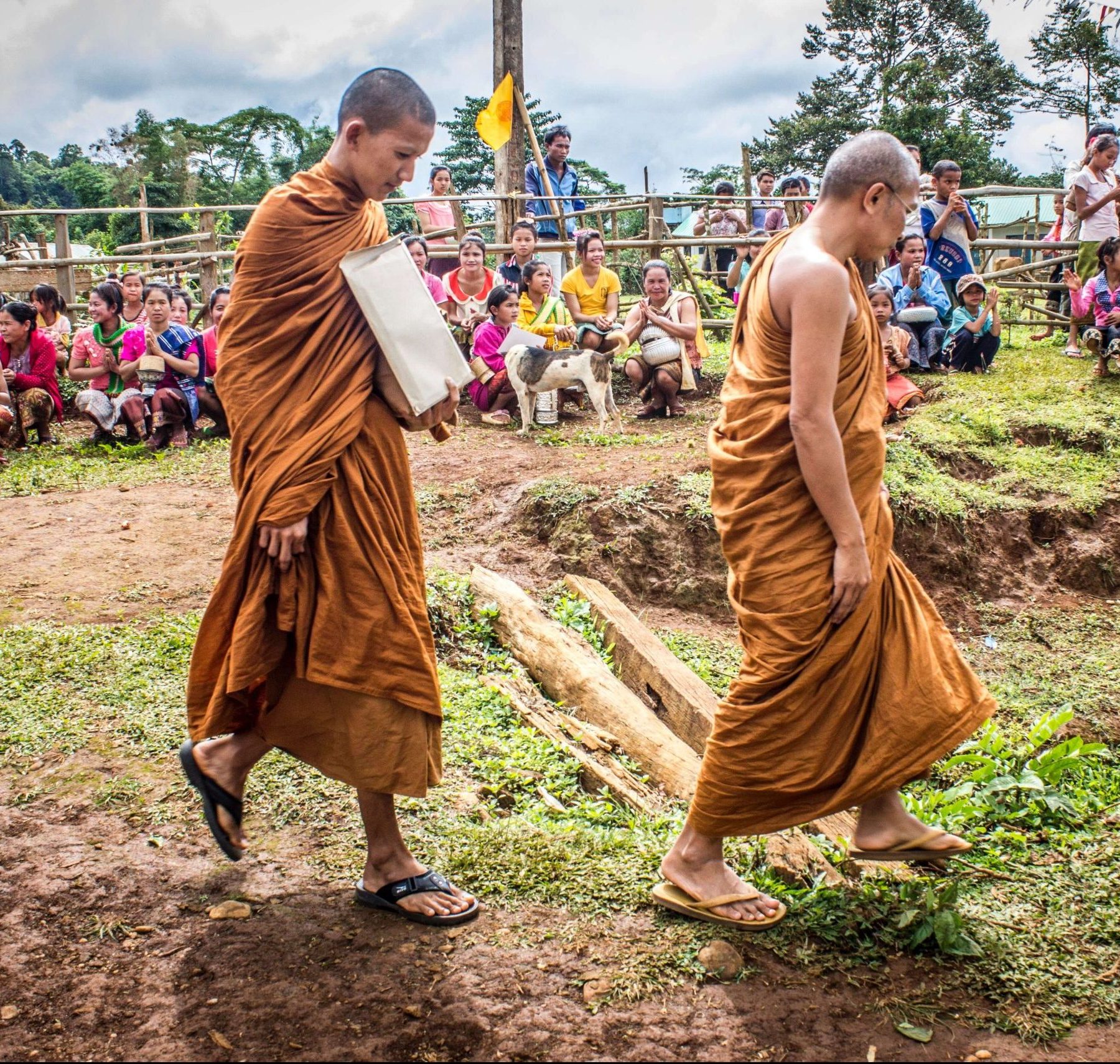
The Theravāda monks’ triple robes, called Ticīvara in Pali language, consists of 3 pieces: the upper robe (Uttarāsaṅga) covering the upper body, lower robe (Antaravāsaka) covering the lower body and a double-layer robe (Saṅghāti) for use during cold weathers. It is against the monastic rule to use a single, unbroken piece of cloth to make the robes so they are usually stitched together in the formation of rice paddy fields. The robes’ colours range from maroon to dark brown depending on the country and lineage.
When the monastics are not near any inhabited areas, for example in the monastery or in forests, they can wear the upper robe with the right shoulder exposed. However, when they are in inhabited areas, they need to cover both shoulders. Wearing robes with one shoulder exposed was passed down from the Buddha’s time. However, wearing robes covering both shoulders is a recent development1 which started in Myanmar in the mid-18th century. It then spread to other countries with Theravāda Buddhism like Sri Lanka and Thailand.
Initially, nuns wore the same robes as monks. However, when wind blew against the robes of nuns, their breasts became apparent and the lay people jeered at them. To prevent this from happening again, the Buddha made a rule that all nuns had to wear an additional cloth, called Saṃkacchika, to cover the breasts. However, a study was done on the scriptures and found that there was an additional piece of cloth required to be worn by nuns to cover up the shape of the breasts2. So, nuns had to wear 2 additional pieces of cloth compared to monks.
Scriptures
For Theravāda Buddhism, the Pāli , also known as the Pāli Canon is the highest authority upon which monastics depend on for both discourses and monastic rules. The Pāli language is a middle-Indic language which is used for recording the scriptures and for daily chanting. The origin of the Pāli language is highly debatable with A.K. Warder claiming that it came from the north-west of India while K.R. Norman said that it was an amalgamation of various dialects in an attempt to consolidate the scriptures from different areas in India2. The Basket of Monastic Rules and Abhidhamma has been discussed in Part 1 of this series. Here, we shall discuss in detail the various scriptures in the Basket of Discourses.
Dīgha Nikāya (DN)
This is translated as ‘Long Discourses’3 and comprises of 34 discourses. These are the longest discourses available in the Basket of Teachings. Even though this series is deemed as propaganda material, it can be a difficult read for new Buddhist devotees due to the length of the discourses and difficult to understand topics. The Long Discourses is comparable to reading a long story that has multiple volumes.
Majjhima Nikāya (MN)
This is translated as ‘Middle-length Discourses’4 and comprises of 152 discourses. This series is a good start for new Buddhist devotees as it has shorter discourses compared to Long Discourses, wide variety of topics and more interesting due to its story format compared to Connected Discourses. The Middle-length Discourses is comparable to reading a book with story that lasts a single volume.
Saṁyutta Nikāya (SN)
This is translated as ‘Connected Discourses’5 and comprises of 56 topics which altogether have 2,889 discourses. The discourses in this series is shorter than Middle-length Discourses but is a more difficult read due to its condensed format. The Connected Discourses is comparable to reading a technical manual on how to write stories.
Aṅguttara Nikāya (AN)
This is translated as ‘Numbered Discourses’6 and comprises of topics pertaining from Ones to Elevens which altogether have 9.565 discourses. The discourses in this series are as short as those in Connected Discourses but are an easier read albeit having a lot of repetitions. The Numbered Discourses is comparable to reading a book on short stories.
Khuddaka Nikāya (KN)
This is translated as ‘Lesser Discourses’7 and comprises of 15 books generally but the Burmese edition has 18 books. After the Buddha’s extinguishment, there was a period of time when the monks’ community modified and added additional materials to the above 4 series. Eventually, the monks’ community decided to stop doing that to prevent further corruption of the authenticity of the original discourses but wanted to continue collecting the writings of monks and nuns. Therefore, this series was created for this situation. A lot of chanting material is derived from this series including the famous Mettā Sutta and Mangala Sutta. However, the authenticity of whether the Buddha taught the material in this series cannot be ascertained even for seemingly genuine discourses from Udāna (Exclamations) and Sutta Nipāta (The Sutta Collection).
Doctrinal differences
Goal of Theravāda Buddhism
The ultimate aim of Theravāda Buddhism is to attain Arahantship. However, there may be some people who aspire to become a Buddha and this is a very lengthy and arduous aspiration. A person is not considered a Bodhisatta just because of this determination. This person will have to go through countless cycles of death and rebirth as a lay person to train their virtue, knowledge and meditation until a meeting with a Buddha. The Buddha will prophesize his becoming of a Buddha in the future only if his training is mature. Only then can this person be called a Bodhisatta and the goal of becoming a Buddha becomes a reality. Due to the extremely lengthy and arduous process, a lot of aspirants fall off during one of the cycles and turn instead to achieving Arahantship.
Arahantship
An Arahant cannot fall down from his attainment and he is morally perfect, above all beings including deities because he has destroyed all greed, anger and delusion.
Nibbana (Extinguishment)
Theravāda Buddhism considers Nibbana to be a real state whereby after an Arahant dies, the entire being of this Arahant, whether body or mind, will never be found8 in this universe ever again. This is due to the Arahant’s permanent extinguishment of greed, anger and delusion.
Stages of Nibbana
There are 4 stages to Nibbana:
a) Stream-entry (Sotāpanna)
This is the first stage of Nibbana. After achieving this stage, the person has a maximum of 7 more cycles of death and rebirth before he/she will definitely attain Arahantship.
b) Once-return (Sakadāgāmin)
This is the second stage of Nibbana. After achieving this stage, the person will be reborn 1 more time and will definitely attain Arahantship in that life.
c) Non-return (Sakadāgāmin)
This is the third stage of Nibbana. After achieving this stage, the person will be reborn in the Pure Abodes heavenly realm (Suddhāvāsa) and will attain Arahantship in that realm no matter how long it takes.
d) Arahantship
This is the last stage of Nibbana. After achieving this tage, the person will no longer have rebirth and after death and will cease to exist in this universe.
Practice
The way to practise for Theravāda Buddhism is to follow the Noble Eightfold Path.
Demographics
The places with majority of Buddhists practising Theravāda Buddhism are:
- Cambodia
- Laos
- Myanmar
- Sri Lanka
- Thailand
- Yunnan (Mainland China)
Mahāyāna Buddhism
Attire
Chinese Mahāyāna
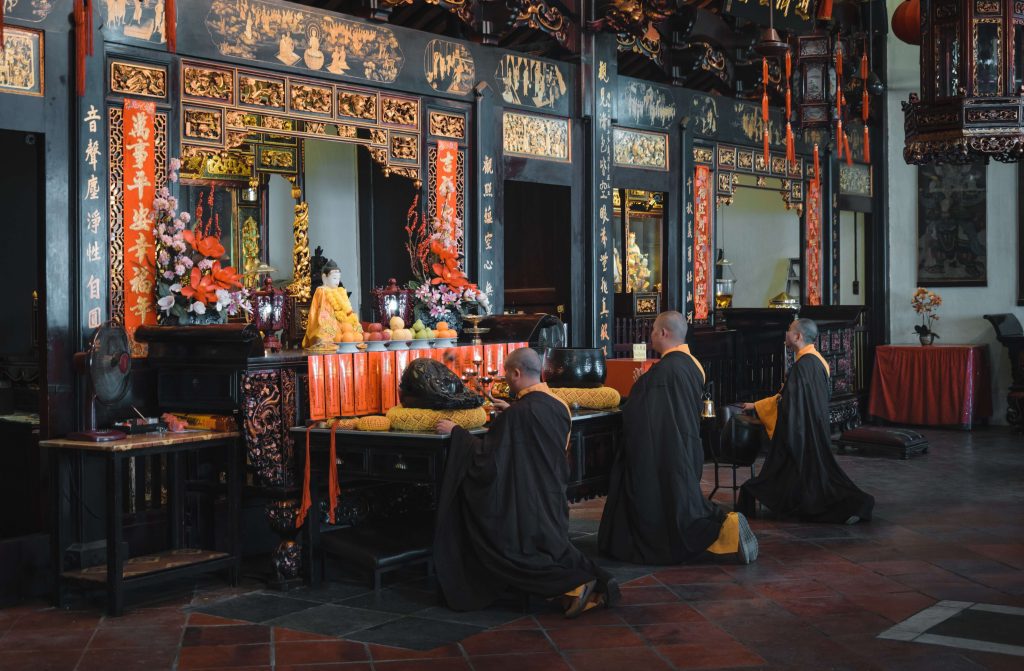
The Chinese Mahāyāna monastics’ robes also consist of an outer robe, upper robe and lower robe. The color of the robes will differ based on lineage. However, the design of the robes changed over the years and are only used during ceremonies. During normal times, the monastics will wear clothes that are more suitable for working like farming and cleaning. This change in attire can be attributed to 2 reasons:
- The weather in China is colder than India; and
- When Mahāyāna Buddhism entered China, the perspectives on respect were very different: Indians felt that revealing the right shoulder showed respect while the Chinese people believed that showing respect meant covering the whole body.
Tibetan
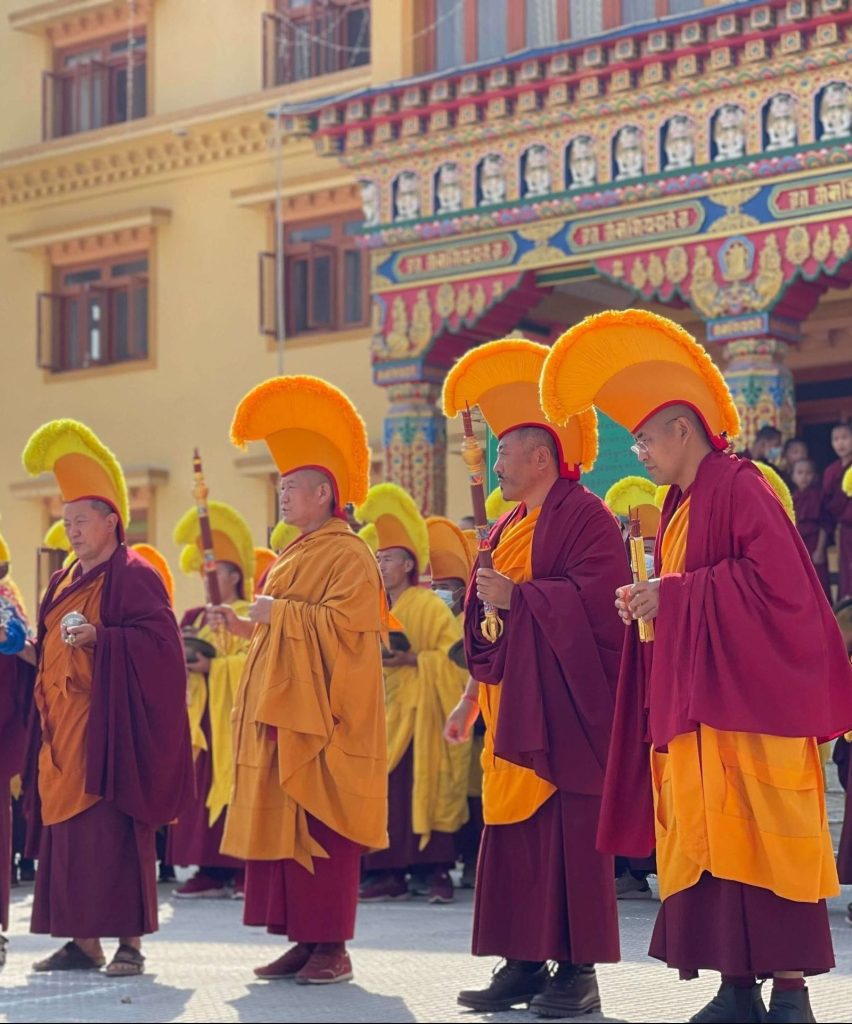
The Tibetan monastics’ robes are as follows:
The dhonka, a wrap shirt with cap sleeves. The dhonka is maroon or maroon and yellow with blue piping.
The shemdap is a maroon skirt made with patched cloth and a varying number of pleats.
The chogyu is something like a sanghati (double-layer robe), a wrap made in patches and worn on the upper body, although sometimes it is draped over one shoulder like a kashaya robe. The chogyu is yellow and worn for certain ceremonies and teachings.
The zhen is similar to the chogyu, but maroon, and is for ordinary day-to-day wear.
The namjar is larger than the chogyu, with more patches, and it is yellow and often made of silk. It is for formal ceremonial occasions and worn kashaya-style, leaving the right arm bare.
Scriptures
For Mahāyāna Buddhism, there are 2 sets of canonical scriptures: the Āgama sutras and the Mahāyāna sutras.
Āgama Sutras
Originally, the Āgama sutras were written in Sanskrit. However, after the Turkish war in 1200 A.D., full texts can only be found in Chinese translations and only small, fragmented parts to be found in Sanskrit and Tibetan. These texts contain discourses from the early Buddhist schools and many academics found high levels of similarities between the Āgama sutras and the Theravāda suttas which indicate that they both originated from the same era. The Āgama sutras have the same categorisation as the Theravāda counterpart:
- Dīrgha Āgama (Long Discouses)
- Madhyama Āgama (Middle Discourses)
- Saṃyukta Āgama (Connected Discourses)
- Ekottara Āgama (Numerical Discourses)
- Kṣudraka Āgama (Minor Discourses)
Mahāyāna Sūtras
After the destruction of the Indian Buddhist Universities and monasteries, academics are unable to ascertain the origins of the Mahāyāna Sūtras. They generally agree that the Sūtras began to appear between 1st century B.C. to 1st century A.D.
Although there were many scriptures in the Mahāyāna Sūtras striving to lay claim to these texts being the ‘words of Buddha’, these were not accepted by Theravāda Buddhism. Even modern, well-known academics like A.K. Warder, Andrew Skilton, Paul Williams and John W. Pettit expressed their doubts9 that these scriptures came from the Buddha. The best conclusion they had was that these scriptures were derived from the Āgama sutras from unknown sources as the basic Mahāyāna concepts of “bodhisattva ethic, emptiness (sunyata), and the recognition of a distinction between buddhahood and arhatship as spiritual ideals” were similar to what the Buddha taught.
Doctrinal differences
Goal of Mahāyāna Buddhism
The ultimate aim of Mahāyāna Buddhism is to become a Buddha. In order to achieve this aim, a Mahāyāna Buddhist will embark on the bodhisattva path. To enter this path, the Mahāyāna Buddhist only needs to make a determination to become a Buddha. There is no need for verification from a living Buddha like in Theravāda Buddhism. After making the determination the Bodhicitta (Thought of Enlightenment) will arise.
Arahatship
Mahāyāna Buddhism does not encourage their practitioners to become an Arahat as it is a ‘lesser’ attainment. Furthermore, they believe that an Arahat can fall down from his attainment.
Nibbana (Extinguishment)
Mahāyāna Buddhism considers there to be 2 states of Nirvāṇa:
a) Pratiṣṭhita Nirvāṇa (localised)
Localised Nirvāṇa means that after attaining enlightenment, the Buddha cannot return to this universe to help other sentient beings.
b) Apratiṣṭhita Nirvāṇa (Non-localised)
Non-localised Nirvāṇa means that after attaining enlightenment, the Buddha is able to return to this universe to help other sentient beings. This is considered to be the most profound type of enlightenment hence the preferred type for Mahāyāna practitioners.
Practice
To train the Bodhicitta, various methods can be used, including:
Bodhisattva vows
From the Lotus Sūtra10, there are 4 vows:
- I will ferry over those who have not yet been ferried over.
- I will make those who have not yet understood to understand.
- I will make those who have not yet settled to be settled.
- I will make those who have not attained nirvana attain nirvana.
Bodhisattva Precepts
According to the Brahmajāla Sūtra11, there are lists of 10 major and 48 minor Bodhisattva precepts:
- Not to kill or encourage others to kill.
- Not to steal or encourage others to steal.
- Not to engage in licentious acts or encourage others to do so. A monk is expected to abstain from sexual conduct entirely.
- Not to use false words and speech, or encourage others to do so.
- Not to trade or sell alcoholic beverages or encourage others to do so.
- Not to broadcast the misdeeds or faults of the Buddhist assembly, nor encourage others to do so.
- Not to praise oneself and speak ill of others, or encourage others to do so.
- Not to be stingy, or encourage others to do so.
- Not to harbor anger or encourage others to be angry.
- Not to speak ill of the Buddha, the Dharma or the Sangha (the Triple Jewel) or encourage others to do so.
Pāramitās (Six Perfections)
In the Prajñapāramitā Sūtras12, the six perfections are:
- Dāna pāramitā (generosity)
- Śīla pāramitā (virtue, proper conduct)
- Kṣānti pāramitā (patient endurance)
- Vīrya pāramitā (energy, diligence)
- Dhyāna pāramitā (one-pointed concentration)
- Prajñā pāramitā (wisdom, insight)
Demographics
The places with majority of Buddhists practising Mahāyāna Buddhism are:
- Bhutan
- Mainland China (excluding Yunnan)
- Hong Kong
- Japan
- Korea
- Mongolia
- Nepal
- South East Asia
- Taiwan
Vajrayāna Buddhism
Misconception
There may be some misconception or misunderstanding about Vajrayāna Buddhism because there are people who equate Vajrayāna Buddhism with Tibetan Buddhism. Although Tibetan Buddhism has more prominent and a larger number of tantric practices originating from Vajrayāna Buddhism, it does not mean Tibetan monastics only do tantric practices. They also follow Mahāyāna Sūtras. Tantric practices are also present, albeit in smaller proportions, in Mahāyāna and Theravāda Buddhism.
Scriptures
It is difficult to do academic research on Vajrayāna Buddhism13 due to the following reasons:
- Unsystematic recording of scriptures.
- Esoteric nature of Vajrayāna Buddhism means that not much information is divulged outside of the teacher-student circle.
- The culture practising Vajrayāna Buddhism must also be studied in conjunction.
- The rituals used must also be studied in conjunction but again these are not easily accessible.
Doctrinal differences
Generally, Vajrayāna Buddhism share the same basic tenets as Mahāyāna Buddhism. The difference lies in the way each school practises to achieve the same goal of Buddhahood.
Practice
Tantric practices are core to Vajrayāna Buddhism but not exclusive to them as shown in the list below:
Mantras
Mantras are considered to be sacred utterances. Practitioners believe that there are magical and spiritual power in these sacred utterances. Mantras are practised in all 3 schools. Examples of mantras include:
a) Theravāda Buddhism
In the Thai Forest Tradition, the word ‘Buddho’ (This is the masculine form of ‘Buddha’) is used as a mantra to help gain concentration.
b) Mahāyāna Buddhism
There are a number of mantras in Mahāyāna Buddhism. One example is the Mahācundi Dhāraṇī: 南無颯哆喃。三藐三菩陀。俱胝喃。怛侄他。唵。折戾主戾。準提娑婆訶。(Adoration to ‘seven billions perfect status, perfect enlightened beings’, like this: om chai’lei zhu’lei Chundi (the Extreme purity).)
c) Vajrayāna Buddhism
The most popular mantra for Vajrayāna Buddhism is Om mani padme hum. This is a six syllable mantra of the Bodhisattva of compassion Avalokiteśvara, 4-armed version.
Dhāraṇī
Dhāraṇī means Buddhist chantings. In 21st century Buddhism, all schools have chanting texts and for the vast majority of temples and monasteries, it is common to have 2 daily chanting sessions in dawn and dusk. The chanting texts differs according to countries and lineages. However, there will be a standard chanting text that all monks in the same school will know.
a) Theravāda Buddhism
Paritta chanting is the standard Darani for Theravāda Buddhism. The chanting texts can be categorised as being reverential, aid seeking and blessing.
b) Mahāyāna and Vajrayāna Buddhism
The most significant and popular daranis for Mahāyāna and Vajrayāna Buddhism are the Lotus Sutra and Heart Sutra.
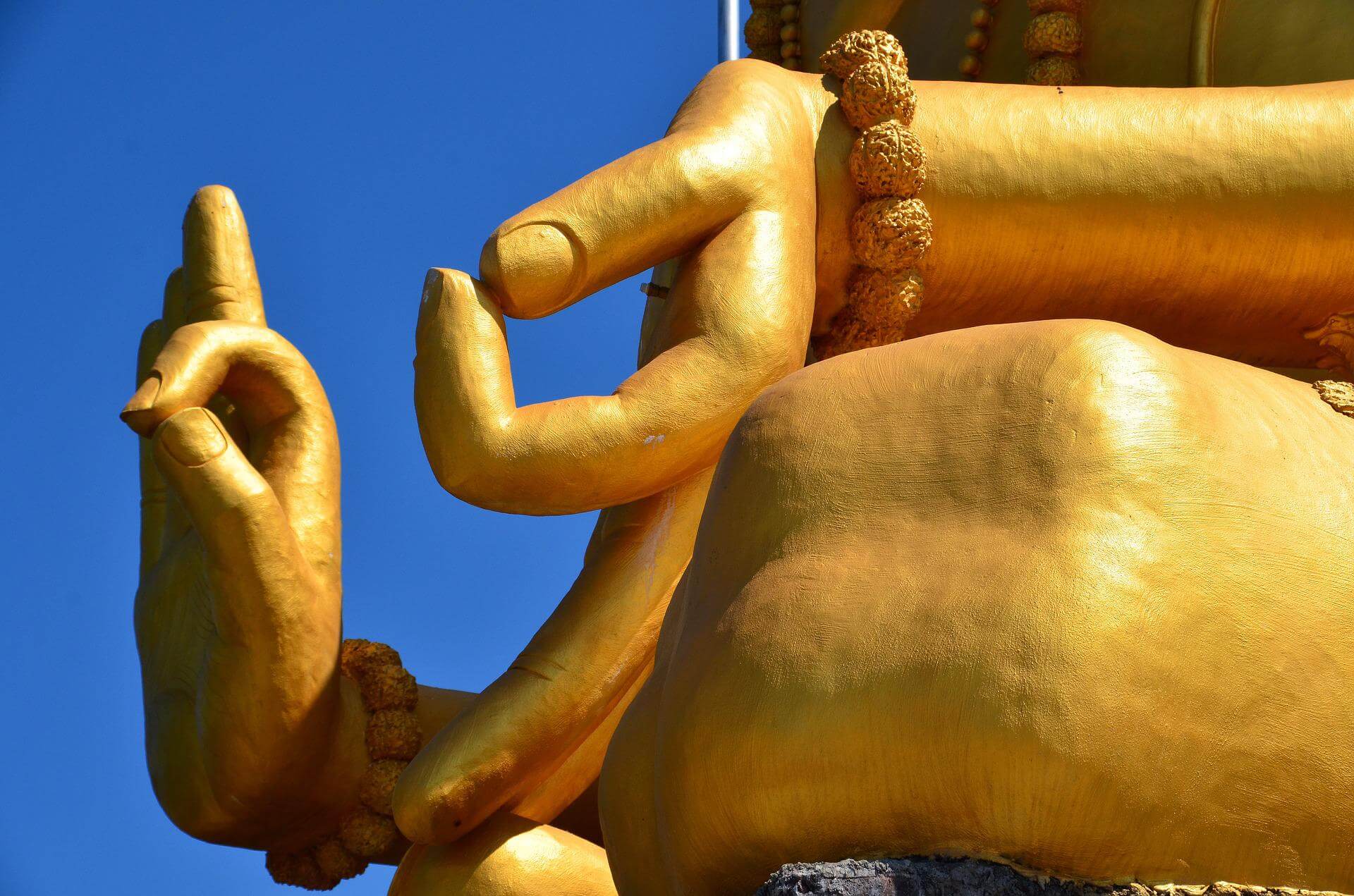
Mudra
Mudra are ritual gestures. These appear predominantly in Vajrayāna Buddhism.
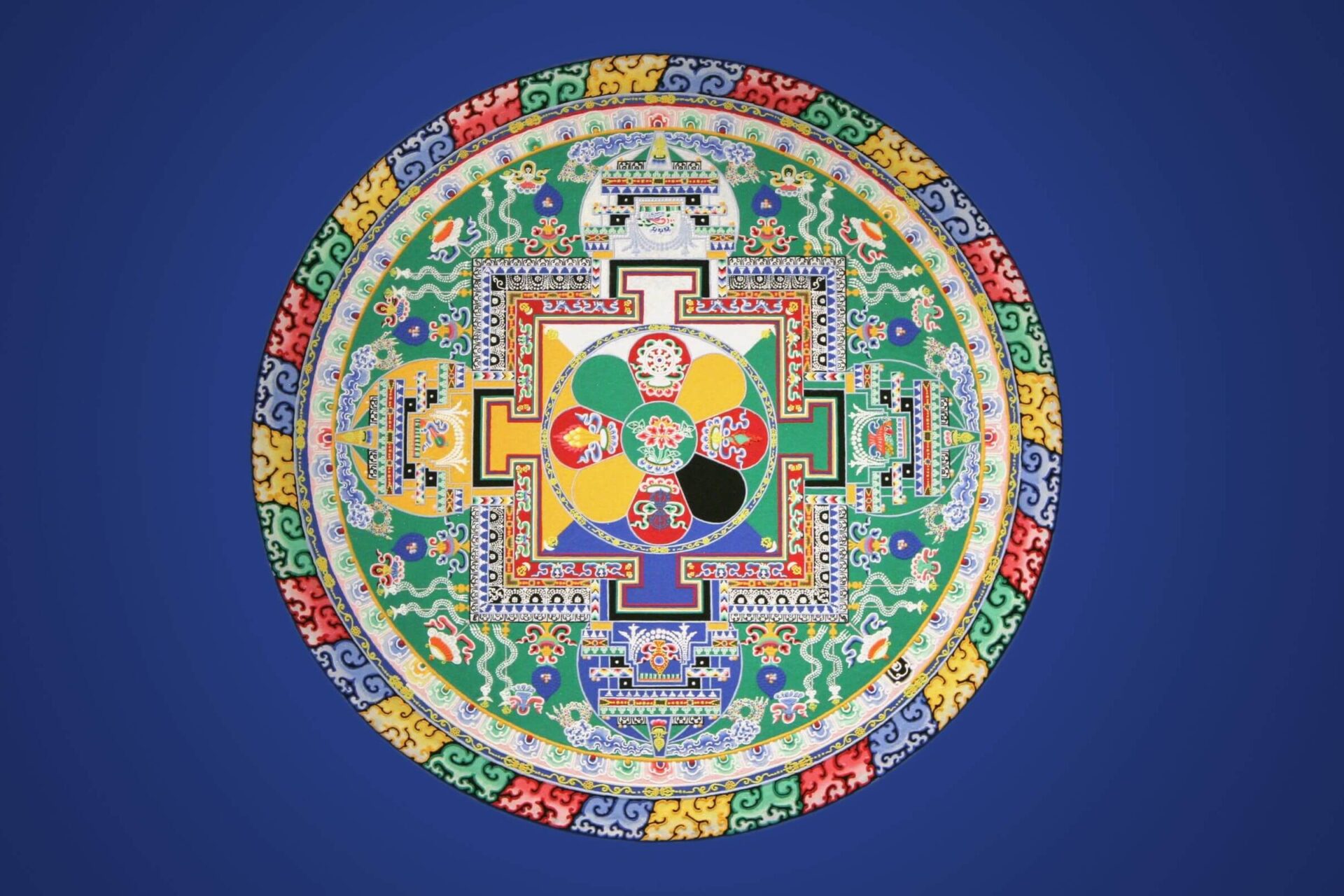
Mandala
Mandala are geometric configuration of symbols. These appear predominantly in Vajrayāna Buddhism.
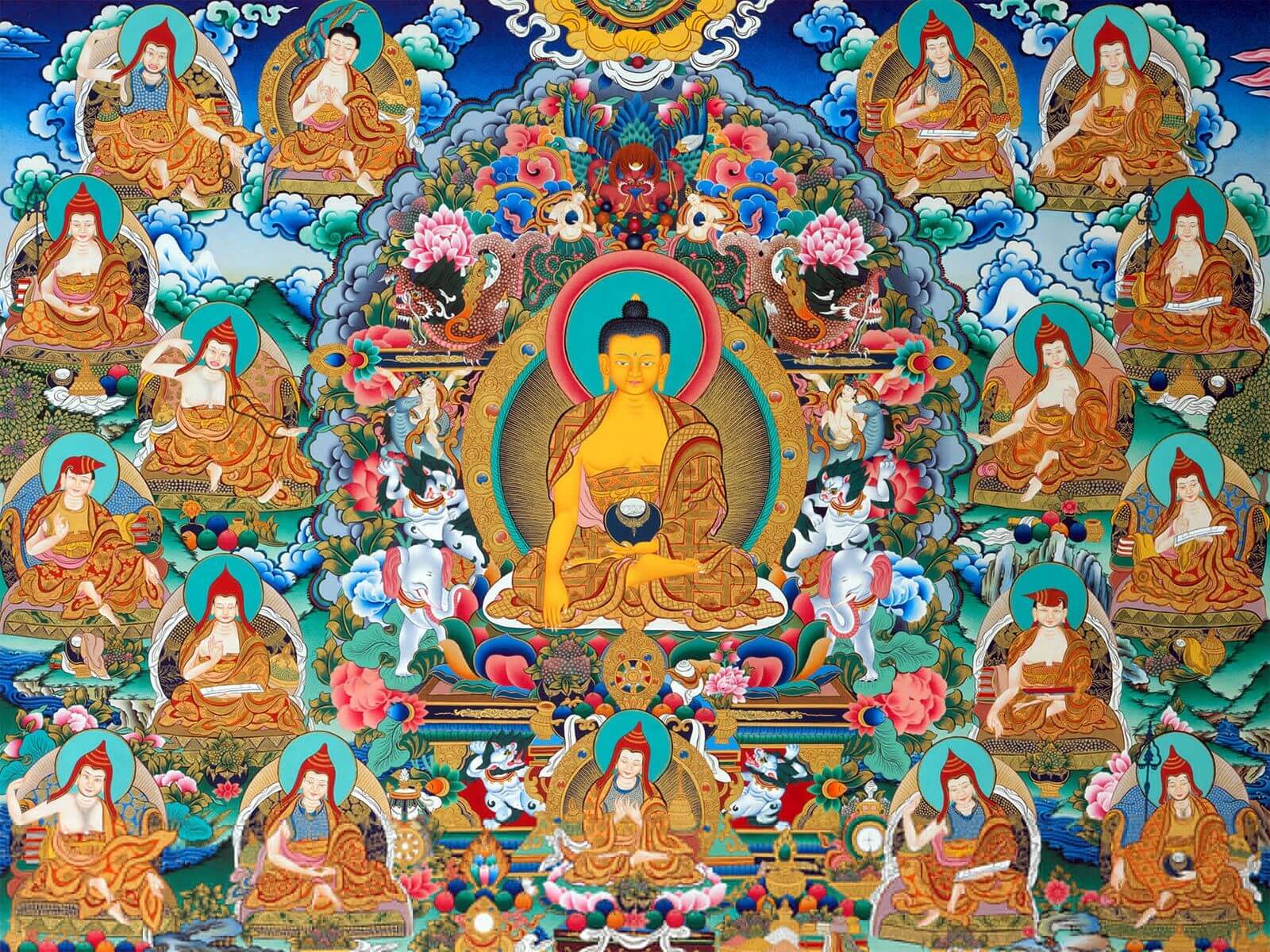
Visualisation of deities and Buddhas
These appear predominantly in Vajrayāna Buddhism.
Demographics
The places with majority of Buddhists practising Vajrayāna Buddhism are:
- Tibet (in the form of Tibetan Buddhism)
- Nepal (in the form of Tibetan Buddhism)
- Japan (in the form of Japanese Esoteric Buddhism known as “Shingon”)
